Tianqi Zhang
Sherman
Physics-Aware Robotic Palletization with Online Masking Inference
Feb 19, 2025Abstract:The efficient planning of stacking boxes, especially in the online setting where the sequence of item arrivals is unpredictable, remains a critical challenge in modern warehouse and logistics management. Existing solutions often address box size variations, but overlook their intrinsic and physical properties, such as density and rigidity, which are crucial for real-world applications. We use reinforcement learning (RL) to solve this problem by employing action space masking to direct the RL policy toward valid actions. Unlike previous methods that rely on heuristic stability assessments which are difficult to assess in physical scenarios, our framework utilizes online learning to dynamically train the action space mask, eliminating the need for manual heuristic design. Extensive experiments demonstrate that our proposed method outperforms existing state-of-the-arts. Furthermore, we deploy our learned task planner in a real-world robotic palletizer, validating its practical applicability in operational settings.
Predictive Lagrangian Optimization for Constrained Reinforcement Learning
Jan 25, 2025

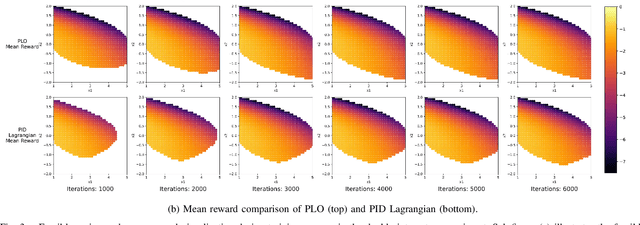
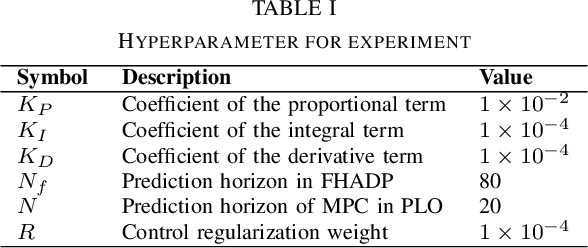
Abstract:Constrained optimization is popularly seen in reinforcement learning for addressing complex control tasks. From the perspective of dynamic system, iteratively solving a constrained optimization problem can be framed as the temporal evolution of a feedback control system. Classical constrained optimization methods, such as penalty and Lagrangian approaches, inherently use proportional and integral feedback controllers. In this paper, we propose a more generic equivalence framework to build the connection between constrained optimization and feedback control system, for the purpose of developing more effective constrained RL algorithms. Firstly, we define that each step of the system evolution determines the Lagrange multiplier by solving a multiplier feedback optimal control problem (MFOCP). In this problem, the control input is multiplier, the state is policy parameters, the dynamics is described by policy gradient descent, and the objective is to minimize constraint violations. Then, we introduce a multiplier guided policy learning (MGPL) module to perform policy parameters updating. And we prove that the resulting optimal policy, achieved through alternating MFOCP and MGPL, aligns with the solution of the primal constrained RL problem, thereby establishing our equivalence framework. Furthermore, we point out that the existing PID Lagrangian is merely one special case within our framework that utilizes a PID controller. We also accommodate the integration of other various feedback controllers, thereby facilitating the development of new algorithms. As a representative, we employ model predictive control (MPC) as the feedback controller and consequently propose a new algorithm called predictive Lagrangian optimization (PLO). Numerical experiments demonstrate its superiority over the PID Lagrangian method, achieving a larger feasible region up to 7.2% and a comparable average reward.
Fine-grained graph representation learning for heterogeneous mobile networks with attentive fusion and contrastive learning
Dec 10, 2024



Abstract:AI becomes increasingly vital for telecom industry, as the burgeoning complexity of upcoming mobile communication networks places immense pressure on network operators. While there is a growing consensus that intelligent network self-driving holds the key, it heavily relies on expert experience and knowledge extracted from network data. In an effort to facilitate convenient analytics and utilization of wireless big data, we introduce the concept of knowledge graphs into the field of mobile networks, giving rise to what we term as wireless data knowledge graphs (WDKGs). However, the heterogeneous and dynamic nature of communication networks renders manual WDKG construction both prohibitively costly and error-prone, presenting a fundamental challenge. In this context, we propose an unsupervised data-and-model driven graph structure learning (DMGSL) framework, aimed at automating WDKG refinement and updating. Tackling WDKG heterogeneity involves stratifying the network into homogeneous layers and refining it at a finer granularity. Furthermore, to capture WDKG dynamics effectively, we segment the network into static snapshots based on the coherence time and harness the power of recurrent neural networks to incorporate historical information. Extensive experiments conducted on the established WDKG demonstrate the superiority of the DMGSL over the baselines, particularly in terms of node classification accuracy.
Spatial-Temporal Attention Model for Traffic State Estimation with Sparse Internet of Vehicles
Jul 10, 2024
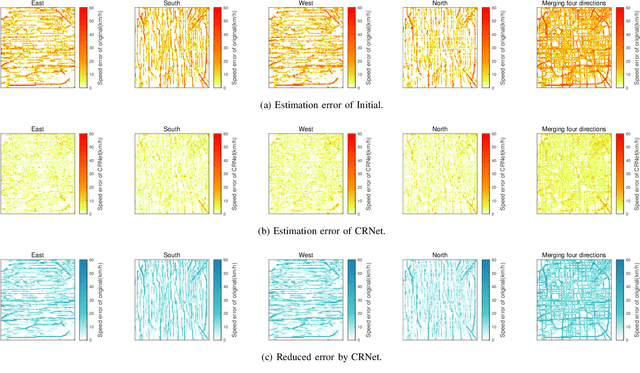
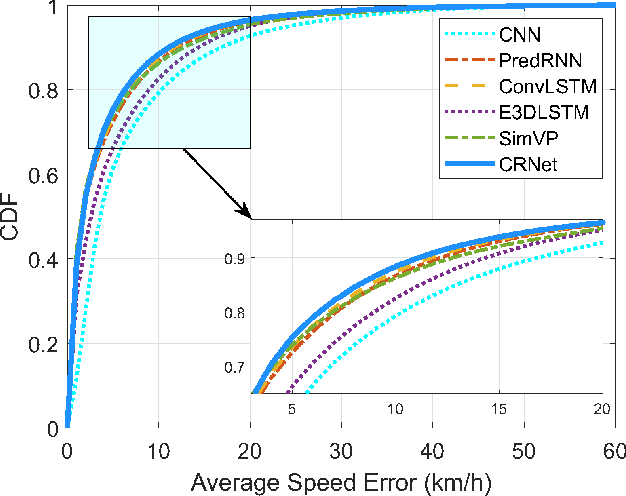

Abstract:The growing number of connected vehicles offers an opportunity to leverage internet of vehicles (IoV) data for traffic state estimation (TSE) which plays a crucial role in intelligent transportation systems (ITS). By utilizing only a portion of IoV data instead of the entire dataset, the significant overheads associated with collecting and processing large amounts of data can be avoided. In this paper, we introduce a novel framework that utilizes sparse IoV data to achieve cost-effective TSE. Particularly, we propose a novel spatial-temporal attention model called the convolutional retentive network (CRNet) to improve the TSE accuracy by mining spatial-temporal traffic state correlations. The model employs the convolutional neural network (CNN) for spatial correlation aggregation and the retentive network (RetNet) based on the attention mechanism to extract temporal correlations. Extensive simulations on a real-world IoV dataset validate the advantage of the proposed TSE approach in achieving accurate TSE using sparse IoV data, demonstrating its cost effectiveness and practicality for real-world applications.
SBoRA: Low-Rank Adaptation with Regional Weight Updates
Jul 10, 2024



Abstract:This paper introduces Standard Basis LoRA (SBoRA), a novel parameter-efficient fine-tuning approach for Large Language Models that builds upon the pioneering works of Low-Rank Adaptation (LoRA) and Orthogonal Adaptation. SBoRA further reduces the computational and memory requirements of LoRA while enhancing learning performance. By leveraging orthogonal standard basis vectors to initialize one of the low-rank matrices, either A or B, SBoRA enables regional weight updates and memory-efficient fine-tuning. This approach gives rise to two variants, SBoRA-FA and SBoRA-FB, where only one of the matrices is updated, resulting in a sparse update matrix with a majority of zero rows or columns. Consequently, the majority of the fine-tuned model's weights remain unchanged from the pre-trained weights. This characteristic of SBoRA, wherein regional weight updates occur, is reminiscent of the modular organization of the human brain, which efficiently adapts to new tasks. Our empirical results demonstrate the superiority of SBoRA-FA over LoRA in various fine-tuning tasks, including commonsense reasoning and arithmetic reasoning. Furthermore, we evaluate the effectiveness of QSBoRA on quantized LLaMA models of varying scales, highlighting its potential for efficient adaptation to new tasks. Code is available at https://github.com/cityuhkai/SBoRA
Coverage Analysis of Downlink Transmission in Multi-Connectivity Cellular V2X Networks
May 27, 2024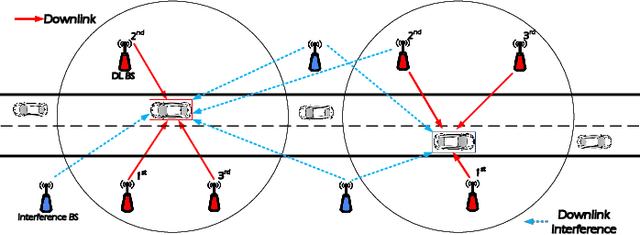

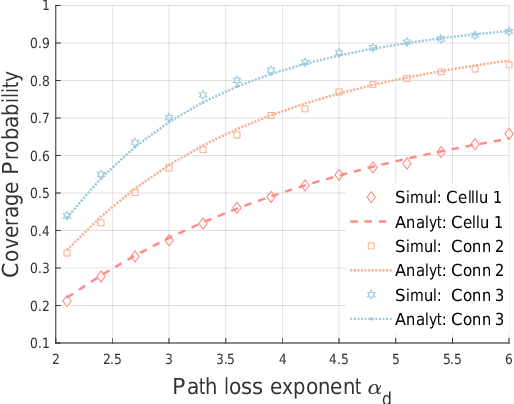
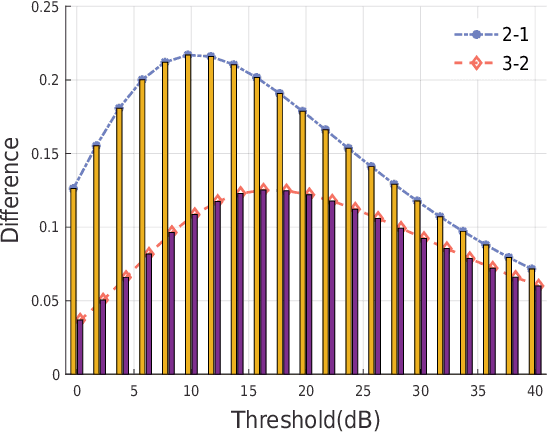
Abstract:With the increasing of connected vehicles in the fifth-generation mobile communication networks (5G) and beyond 5G (B5G), ensuring the reliable and high-speed cellular vehicle-to-everything (C-V2X) communication has posed significant challenges due to the high mobility of vehicles. For improving the network performance and reliability, multi-connectivity technology has emerged as a crucial transmission mode for C-V2X in the 5G era. To this end, this paper proposes a framework for analyzing the performance of multi-connectivity in C-V2X downlink transmission, with a focus on the performance indicators of joint distance distribution and coverage probability. Specifically, we first derive the joint distance distribution of multi-connectivity. By leveraging the tools of stochastic geometry, we then obtain the analytical expressions of coverage probability based on the previous results for general multi-connectivity cases in C-V2X. Subsequently, we evaluate the effect of path loss exponent and downlink base station density on coverage probability based on the proposed analytical framework. Finally, extensive Monte Carlo simulations are conducted to validate the effectiveness of the proposed analytical framework and the simulation results reveal that multi-connectivity technology can significantly enhance the coverage probability in C-V2X.
* 6 pagers, 5 figures. arXiv admin note: substantial text overlap with arXiv:2404.17823
Performance Analysis for Downlink Transmission in Multi-Connectivity Cellular V2X Networks
Apr 27, 2024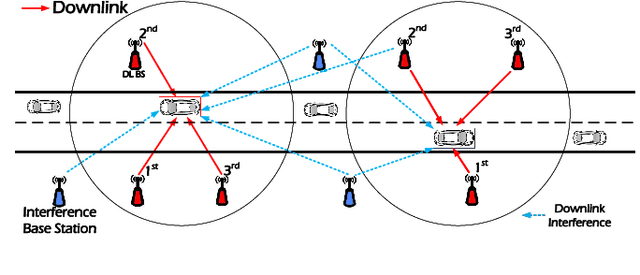

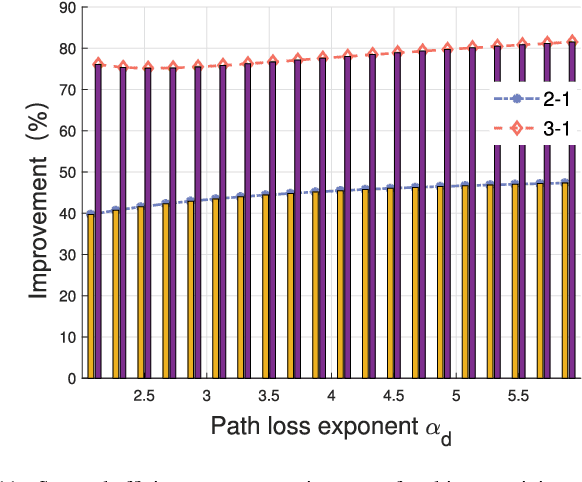
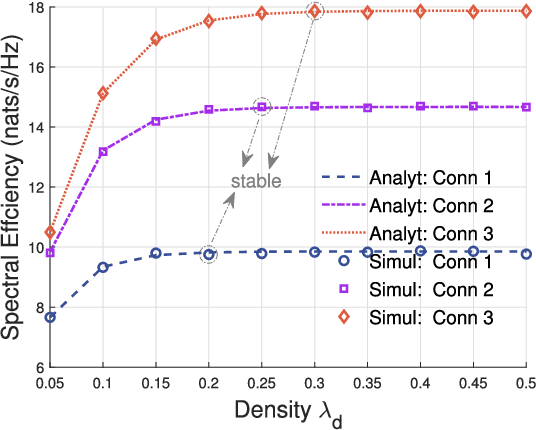
Abstract:With the ever-increasing number of connected vehicles in the fifth-generation mobile communication networks (5G) and beyond 5G (B5G), ensuring the reliability and high-speed demand of cellular vehicle-to-everything (C-V2X) communication in scenarios where vehicles are moving at high speeds poses a significant challenge.Recently, multi-connectivity technology has become a promising network access paradigm for improving network performance and reliability for C-V2X in the 5G and B5G era. To this end, this paper proposes an analytical framework for the performance of downlink in multi-connectivity C-V2X networks. Specifically, by modeling the vehicles and base stations as one-dimensional Poisson point processes, we first derive and analyze the joint distance distribution of multi-connectivity. Then through leveraging the tools of stochastic geometry, the coverage probability and spectral efficiency are obtained based on the previous results for general multi-connectivity cases in C-V2X. Additionally, we evaluate the effect of path loss exponent and the density of downlink base station on system performance indicators. We demonstrate through extensive Monte Carlo simulations that multi-connectivity technology can effectively enhance network performance in C-V2X. Our findings have important implications for the research and application of multi-connectivity C-V2X in the 5G and B5G era.
The Earth is Flat because: Investigating LLMs' Belief towards Misinformation via Persuasive Conversation
Dec 29, 2023Abstract:Large Language Models (LLMs) encapsulate vast amounts of knowledge but still remain vulnerable to external misinformation. Existing research mainly studied this susceptibility behavior in a single-turn setting. However, belief can change during a multi-turn conversation, especially a persuasive one. Therefore, in this study, we delve into LLMs' susceptibility to persuasive conversations, particularly on factual questions that they can answer correctly. We first curate the Farm (i.e., Fact to Misinform) dataset, which contains factual questions paired with systematically generated persuasive misinformation. Then, we develop a testing framework to track LLMs' belief changes in a persuasive dialogue. Through extensive experiments, we find that LLMs' correct beliefs on factual knowledge can be easily manipulated by various persuasive strategies.
SpecHD: Hyperdimensional Computing Framework for FPGA-based Mass Spectrometry Clustering
Nov 20, 2023Abstract:Mass spectrometry-based proteomics is a key enabler for personalized healthcare, providing a deep dive into the complex protein compositions of biological systems. This technology has vast applications in biotechnology and biomedicine but faces significant computational bottlenecks. Current methodologies often require multiple hours or even days to process extensive datasets, particularly in the domain of spectral clustering. To tackle these inefficiencies, we introduce SpecHD, a hyperdimensional computing (HDC) framework supplemented by an FPGA-accelerated architecture with integrated near-storage preprocessing. Utilizing streamlined binary operations in an HDC environment, SpecHD capitalizes on the low-latency and parallel capabilities of FPGAs. This approach markedly improves clustering speed and efficiency, serving as a catalyst for real-time, high-throughput data analysis in future healthcare applications. Our evaluations demonstrate that SpecHD not only maintains but often surpasses existing clustering quality metrics while drastically cutting computational time. Specifically, it can cluster a large-scale human proteome dataset-comprising 25 million MS/MS spectra and 131 GB of MS data-in just 5 minutes. With energy efficiency exceeding 31x and a speedup factor that spans a range of 6x to 54x over existing state of-the-art solutions, SpecHD emerges as a promising solution for the rapid analysis of mass spectrometry data with great implications for personalized healthcare.
Spectral Efficiency Analysis of Uplink-Downlink Decoupled Access in C-V2X Networks
Dec 12, 2022



Abstract:The uplink (UL)/downlink (DL) decoupled access has been emerging as a novel access architecture to improve the performance gains in cellular networks. In this paper, we investigate the UL/DL decoupled access performance in cellular vehicle-to-everything (C-V2X). We propose a unified analytical framework for the UL/DL decoupled access in C-V2X from the perspective of spectral efficiency (SE). By modeling the UL/DL decoupled access C-V2X as a Cox process and leveraging the stochastic geometry, we obtain the joint association probability, the UL/DL distance distributions to serving base stations and the SE for the UL/DL decoupled access in C-V2X networks with different association cases. We conduct extensive Monte Carlo simulations to verify the accuracy of the proposed unified analytical framework, and the results show a better system average SE of UL/DL decoupled access in C-V2X.
 Add to Chrome
Add to Chrome Add to Firefox
Add to Firefox Add to Edge
Add to Edge